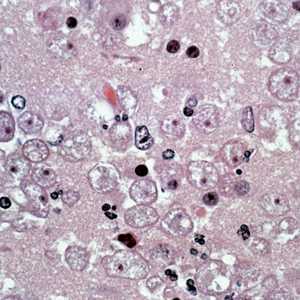Diagnosis & Detection
Clinicians: For 24/7 diagnostic assistance, specimen collection guidance, shipping instructions, and treatment recommendations, please contact the CDC Emergency Operations Center at 770-488-7100.

Several trophozoites of B. mandrillaris in brain tissue, stained with hematoxylin and eosin (H&E).
Balamuthia Granulomatous Amebic Encephalitis (GAE) is a serious infection of the brain and spinal cord caused by Balamuthia 1,2,3,4. GAE is often diagnosed only after death. However, it can be diagnosed by examining blood, cerebrospinal fluid, and tissue samples from a living patient as well. Diagnosis of GAE in a living patient is less common because the amebas are difficult to identify under the microscope, even with commonly used stains 5.
However, there are three types of tests that can help confirm the diagnosis of GAE. The indirect immunofluorescence assay (IFA) is a test used to detect antibodies attached to Balamuthia amebas in body tissues. In contrast, immunohistochemistry (IHC) uses specific antibodies against Balamuthia to detect the amebas. Finally, a polymerase chain reaction (PCR) molecular assay can detect Balamuthia DNA 5.
The Centers for Disease Control and Prevention (CDC) offers diagnostic assistance for Balamuthia to physicians and scientists through DPDx.
References
- Siddiqui R, Khan NA. Balamuthia amoebic encephalitis: an emerging disease with fatal consequences. Microb Pathog. 2008;44(2):89-97.
- Perez MT, Bush LM. Fatal amebic encephalitis caused by Balamuthia mandrillaris in an immunocompetent host: a clinicopathological review of pathogenic free-living amebae in human hosts. Ann Diagn Pathol. 2007;11(6):440-447.
- Perez MT, Bush LM. Balamuthia mandrillaris amebic encephalitis. Curr Infect Dis Rep. 2007;9(4):323-328.
- Maciver SK. The threat from Balamuthia mandrillaris. J Med Microbiol. 2007;56(Pt 1):1-3.
- Kiderlen AF, Radam E, Lewin A. Detection of Balamuthia mandrillaris DNA by real-time PCR targeting the RNase P gene. BMC Microbiol. 2008;8:210.
- Page last reviewed: February 17, 2016
- Page last updated: February 17, 2016
- Content source:


 ShareCompartir
ShareCompartir